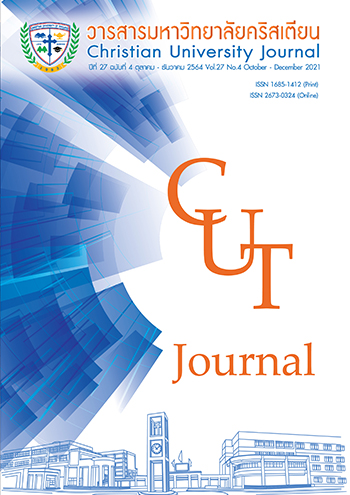การตัดสินใจซื้อเครื่องดื่มเพื่อสุขภาพ ประเภทเวย์โปรตีน ของกลุ่มเจเนอเรชันวาย โดยประยุกต์ใช้ทฤษฎีพฤติกรรมตามแบบแผน
คำสำคัญ:
เวย์โปรตีน, ทัศนคติต่อพฤติกรรม, การคล้อยตามกลุ่มอ้างอิง, การรับรู้ความสามารถในการควบคุมพฤติกรรม, ประสบการณ์บริโภคบทคัดย่อ
การวิจัยในครั้งนี้มีวัตถุประสงค์เพื่อศึกษาความตั้งใจซื้อเวย์โปรตีนและประสบการณ์บริโภคของกลุ่มเจเนอเรชันวายในจังหวัดกรุงเทพมหานคร จึงได้นำทฤษฎีพฤติกรรมตามแบบแผน (Theory of Planned Behavior) ซึ่งได้ศึกษาทัศนคติต่อพฤติกรรม การคล้อยตามกลุ่มอ้างอิง การรับรู้ความสามารถในการควบคุมพฤติกรรม ความตั้งใจซื้อ และประสบการณ์บริโภคที่ใช้ศึกษาการตัดสินใจซื้อเครื่องดื่มเพื่อสุขภาพ ประเภทเวย์โปรตีน โดยเลือกใช้การกำหนดกลุ่มตัวอย่างแบบเจาะจง คือ ลักษณะกลุ่มตัวอย่างที่มีอายุระหว่าง 21-40 ปี อาศัยอยู่ในจังหวัดกรุงเทพมหานครที่มีประสบการณ์บริโภคเวย์โปรตีนและอยู่ในช่วงเจเนอเรชันวาย จำนวน 400 คน โดยใช้วิธีการสำรวจ และใช้แบบสอบถามออนไลน์เป็นเครื่องมือในการเก็บรวบรวมข้อมูล ผลการศึกษานี้ พบว่า ปัจจัยด้านทัศนคติต่อพฤติกรรม การคล้อยตามกลุ่มอ้างอิง การรับรู้ความสามารถในการควบคุมพฤติกรรม ประสบการณ์บริโภคส่งผ่านตัวแปรทัศนคติต่อพฤติกรรม และประสบการณ์บริโภคส่งผลต่อความตั้งใจซื้อเวย์โปรตีน
เอกสารอ้างอิง
จุฑารัตน์ อยู่สุขเจริญ, เกษร สำเภาทอง และพรทิพย์ จอมพุก. (2561). ปัจจัยทำนายความตั้งใจเลิกสูบบุหรี่ของผู้ป่วยโรคไม่ติดต่อเรื้อรัง โรงพยาบาลเฉลิมพระเกียรติ. วารสารพยาบาลสาธารณสุข, 32(2), 138-153.
ปานชนก มณีไมตรีจิต, วริษา สุกิตติพัฒนากุล และสุขวสา นันทวิภาวงศ์. (2559). ปัจจัยทำนายพฤติกรรมการอู้งานผ่านการใช้อินเทอร์เน็ตในพนักงานเจเนอเรชันวาย. จุฬาลงกรณ์มหาวิทยาลัย.
Ajzen, I. (1985). From intentions to actions: A theory of planned behavior. In Action control, New York: Springer.
Ajzen, I., & Fishbein, M. (2000). Perceived behavioral control, self-efficacy, locus of control, and the theory of planned behavior. Journal of applied social psychology, 32(4), 665-683.
Arbuckle, J. L. (2010). IBM SPSS Amos 19 user’s guide. Amos Development Corporation. USA: Crawfordville, FL.
Byrne, B. M. (2001). Structural equation modeling with AMOS: Basic concepts. Applications and programming, Multivariate Applications Series. New Jersey: Lawrence Erlbaum Associates, Hillsdale.
Cochran, W. G. (1977). Sampling techniques. (3rd ed.). New York: John Wiley & Sons.
Davis, F. D. (1989). Perceived usefulness, perceived ease of use and user acceptance of information technology. MIS quarterly, 13(3), 319-340.
Drost, E. A. (2011). Validity and reliability in social science research. Education Research and perspectives, 38(1), 105-123.
Euromonitor. (2020). Global Trends in Protein. Retrieved from https://www.euromonitor.com/global-trends-in-protein/report.
Fishbein, M., & Ajzen, I. (1975). Belief, Attitude, Intention, and Behavior: An introduction to theory and research. Reading, MA: Addison-Wesley Publishing Company.
Gallarza, M. G., & Saura, I. G. (2006). Value dimensions, perceived value, satisfaction and loyalty: an investigation of university students’ travel Behavior. Tourism management, 27(3), 437-452.
Hair, J. F., Black, W. C., Babin, B. J., Anderson, R. E., & Tatham, R. L. (1998). Multivariate data analysis. (5th ed). Englewood cliffs, NJ: Prentice Hall.
Hernández, B., Jiménez, J., & Martín, M. J. (2010). Customer behavior in electronic commerce: The moderating effect of e-purchasing experience. Journal of business research, 63(9-10), 964-971.
Keogh, C., Li, C., & Gao, Z. (2019). Evolving consumer trends for whey protein sports supplements: The Heckman ordered probit estimation. Agricultural and food economics, 7(1), 1-10.
Lemke, F., Clark, M., & Wilson, H. (2011). Customer experience quality: An exploration in business and consumer contexts using repertory grid technique. Journal of the academy of marketing science, 39(6), 846-869.
Londono, J. C., Davies, K., & Elms, J. (2017). Extending the theory of planned behavior to examine the role of anticipated negative emotions on channel intention: The case of an embarrassing product. Journal of Retailing and Consumer Services, 36, 8-20.
Lung-Guang, N. (2019). Decision-making determinants of students participating in MOOCs: Merging the theory of planned behavior and self-regulated learning model. Computers & Education, 134, 50-62.
Mohammad, A. A. S. (2017). The impact of brand experiences, brand equity and corporate branding on brand loyalty: Evidence from Jordan. International Journal of Academic Research in Accounting, finance and management sciences, 7(3), 58-69.
Nunnally, J. C., & Bernstein, I. H. (1994). Psychometric theory. (3rd ed). New York: McGraw-hill.
Phochai, W. (2019). Brand equity and marketing communications influencing purchase decision toward supplementary food of generation Y in Bangkok. The Journal of Development Administration Research, 9(3), 87-95.
Roos, D., & Hahn, R. (2019). Understanding collaborative consumption: An extension of the theory of planned behavior with value-based personal norms. Journal of Business Ethics, 158(3), 679-697.
Sanook. (2020). Health care statistics of Thai people in 2020. Retrieved from https://www.sanook.com/health/26615/.
Schmitt, B., Brakus, J. J., & Zarantonello, L. (2015). From experiential psychology to consumer experience. Journal of Consumer Psychology, 25(1), 166-171.
Sheth, J. N., Newman, B. I., & Gross, B. L. (1991). Why we buy what we buy: A theory of consumption values. Journal of business research, 22(2), 159-170.
Taylor, S., & Todd, P. (1995). Decomposition and crossover effects in the theory of planned behavior: A study of consumer adoption intentions. International journal of research in marketing, 12(2), 137-155.
Tegova, S. (2010). Application of the theory of planned Behavior to career choice: The role of an improved measure of emotion (Unpublished Master’s thesis). Edith Cowan University, Joondalup, Western Australia.
Teo, A. J., Mishra, A., Park, I., Kim, Y. J., Park, W. T., & Yoon, Y. J. (2016). Polymeric biomaterials for medical implants and devices. ACS Biomaterials Science & Engineering, 2(4), 454-472.
Thompson, R. L., Higgins, C. A., & Howell, J. M. (1991). Personal computing: toward a conceptual model of utilization. MIS quarterly, 15(1), 125-143.
Zhang, L. B., Fan, Y. L., Zhang, W. Y., & Zhang, S. (2019). Extending the theory of planned behavior to explain the effects of cognitive factors across different kinds of green products. Sustainability, 11(15), 4222.
Zhou, M. (2016). Chinese university students' acceptance of MOOCs: A self-determination perspective. Computers & Education, 92, 194-203.



